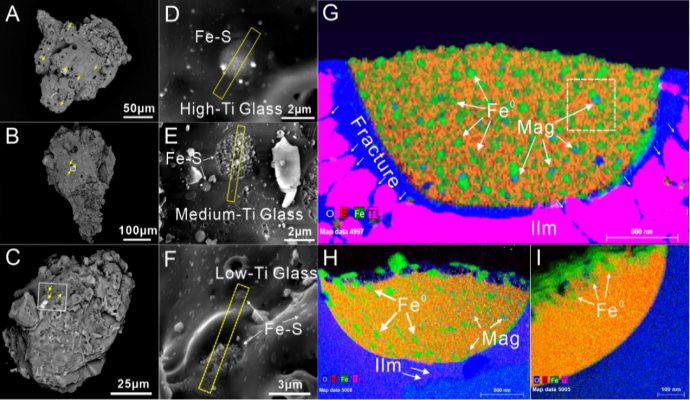The research team led by LI Yang and CAO Zhi at the Institute of Geochemistry, Chinese Academy of Sciences has conducted in-situ electron microanalysis of droplet-like, rounded iron-sulfide grains embedded within impact glasses in the finest Chang’ E-5 lunar soil and confirmed that impact-induced submicroscopic magnetite is ubiquitous in the lunar regolith. The content of magnetite is closely related to the Ti content in the region.
Magnetite is an important oxidized mineral in planetary science and is involved in key questions related to paleomagnetic fields and indicators of life. It is commonly believed to be rare on the reduced lunar surface. Although Mössbauer spectroscopy and electron spin resonance (ESR) studies have hypothesized the prevalence of submicroscopic “magnetite-like” phases in Apollo lunar soils, there is no correlative mineralogical evidence for their genesis and potential distribution on the Moon.
Previous studies have proposed several mechanisms for magnetite production on the Moon, driven either by common lunar interior oxidation conditions or by direct input of exogenous material, giving new insights into localized higher oxygen fugacity environments specific to the Moon. However, it is important to emphasize that the presence of individual magnetite particles produced by various formation mechanisms is incidental and independent, it is hard to extend to the global lunar surface. The formation mechanism of magnetite on the lunar surface still needs to be fully discussed.
LI and CAO’ s study shows that a large number of submicroscopic magnetite particles existed in the droplet-like, rounded iron-sulfide grains embedded within impact glasses, and the content of magnetite is positively correlated with the Ti content in the glass (Figure 1). Microanalysis shows that this type of magnetite is induced by the impact event, and we use the eutectoid reaction mechanism (4FeO = Fe3O4 + Fe) to explain its formation. In addition, the statistical result shows that 7 droplet-like iron-sulfide grains with magnetite on the surface of about 200 glassy grains. The sulfide-droplet-on-glass assemblage is common but has a certain probability, and the formation of magnetite conforms to the rule we emphasized in relation to the Ti content in the impact glass. We believe that the submicroscopic magnetite in the droplet-like iron-sulfide grains provides in-situ mineralogical proof of the sub-microscopic “magnetite-like” phases recognized during the Apollo era, providing a solid basis for the conclusion that impact-induced submicroscopic magnetite may be ubiquitous in the lunar regolith of the high-Ti region.

Figure 1. Droplet-like, rounded iron-sulfide grains embedded within Chang’ e-5 glasses of different Ti content (Image by IGCAS)
The study was published in the journal Science Advances on September 20.
This result confirms for the first time that submicroscopic magnetite particles are common throughout the lunar surface and updates the understanding of the lunar microscale oxidation environment.
Furthermore, Previous studies have confirmed that the magnetic anomaly distribution in the lunar crust may be related to ejecta of large impacts; the potentially ubiquitous production of ferromagnetic minerals reported in this study provides further support for an impact-induced mechanism for lunar surface magnetic anomalies. The sulfides in the liquid outer core and ilmenite carried by the early lunar mantle overturning events came into contact with each other in the high-pressure environment (~4.75 GPa) of the lunar core-mantle boundary may have resulted in the presence of dissolved oxygen in the sulfide and the formation of magnetite in the deep Moon.
The study was supported by the lunar samples from the CNSA and funded by the Strategic Priority Research Program of the Chinese Academy of Sciences; National Natural Science Foundation of China; “From 0 to 1” Original Exploration Cultivation Project, Institute of Geochemistry, Chinese Academy of Sciences; the Youth Innovation Promotion Association, Chinese Academy of Sciences; the China Postdoctoral Science Foundation; and the Pre-Research Project on Civil Aerospace Technologies.
Contact:
LI Yang
Center for Lunar and Planetary Sciences
Institute of Geochemistry, the Chinese Academy of Sciences
Email: liyang@mail.gyig.ac.cn
(By Prof. LI Yang’ s group)